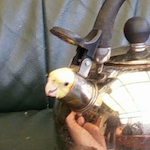|
This is fascinating to read and I would subscribe to your newsletter.
|
|
|
|

|
| # ? May 5, 2024 00:43 |
|
literally a fish posted:All you have to do is put the O2 sensor further downstream 1030C for how long (it's not that long, compared to the lifetime of the vehicle)? Granted, I'm talking about EGT experienced by the O2 sensor, so we're not really talking about the same thing. That said, "move the O2 sensor further downstream" is not a phrase I hear from the OEMs. Larrymer posted:Kinda have to nowadays for fuel economy (smaller displacement boosted stuff). The higher allowable temperature limit of the turbo, the less enrichment needed to cool things down = better fuel economy. Well absolute, I agree, but this is the problem with automotive (well any sort of) engineering, is that you're never operating in a metaphorical-vacuum. Just because you can run more efficiently with higher temperatures doesn't mean you can put that in a car, because you might damage O2 sensors, catalysts, or even packaging could be a problem, as your exhaust system gets too hot and you're not able to protect components around it well enough (or move things far enough away to be protected).
|
|
|
|
Here is a bit of bearing info from a few manufacturers basics of how they work http://kingbearings.com/files/Engine_Bearings_and_How_They_Work.pdf mahle's breakdown of failure modes http://www.mahle-aftermarket.com/media/local-media-north-america/product-files/ceb-2-1114-engine-bearing-failures-brochure.pdf a bit about how bearing clearance http://kingbearings.com/wp-content/uploads/2014/10/optimization-of-clearance-engine-professional.pdf Oh and this has the dimensions of subaru bearings http://kingbearings.com/subaruXPG/king-subaru-Nov26r7.pdf and here is the oil flow path in a subaru  with avcs (Block is the same but this shows the main galleys a little better)  kastein posted:Answer: very That part from crawford about their special water pump makes me laugh every time (it's an oem part). Also how they don't think bigger valves or headwork make a difference. We went on the same dyno at the modified shootout a few years ago. Same turbo, same fuel, same displacement. Yet somehow we made way more power. jamal fucked around with this message at 20:53 on Feb 8, 2016 |
|
|
|
mekilljoydammit posted:Additional to the actual fluid film stuff though is all the other stupid stuff Subaru did. The oil pump pressure relief is bad (albeit in a fairly common way) and helps churn the oil into aerated froth, and the crank oiling scheme makes me wonder what the hell they were thinking. I wish to hell there were an affordable aftermarket crank with Cosworth style oiling but for my built motor I'll probably just suck it up and apply a bunch of cheap bandaid fixes instead; I'm looking into how hard it would be to have a pressure relief that would dump from somewhere else, for example. I think most of the other aftermarket cranks use similar oil flow systems. And i think that cosworth must have gone up in price a bit over the last few years (msrp is like 4100!). An arrow is about 1k less and pretty much the same thing, but i don't know if the have us distribution. The manley seems to be pretty popular among the guys building high power subaru engines right now and less than 1/2 the price of cosworth. And if you are in the us/canada and serious about buying a crank let me know. As far as the oil bypass goes, I don't see why you couldn't plug it, and put a new one inline out the bottom leg of the pump and return it to the front of the pan. Not sure anyone has attempted that. jamal fucked around with this message at 20:37 on Feb 8, 2016 |
|
|
|
jamal posted:Here is a bit of bearing info from a few manufacturers The first two are not bad, though obviously don't go into too much detail. The one from King on engine clearances is really good actually; from their graphs and units, I can tell what they wrote for those graphs was essentially what I was going to start on myself, and all the units are about right. And where can you get the good water pumps from? I totally agree that Crawford makes me roll my eyes sometimes. The "just throw boost at it, ignore breathing" reminds me a lot of the old turbo Dodge guys. jamal posted:I think most of the other aftermarket cranks use similar oil flow systems. And i think that cosworth must have gone up in price a bit over the last few years (msrp is like 4100!). An arrow is about 1k less and pretty much the same thing, but i don't know if the have us distribution. The manley seems to be pretty popular among the guys building high power subaru engines right now and less than 1/2 the price of cosworth. And if you are in the us/canada and serious about buying a crank let me know. From what I can tell, it seems like the Manley/K1/etc use "straight shot" oiling, where the passages go diagonally. It's better than cross-drilled, but anything crossing the crank centerline has some centrifugal issues - you can't pull oil at a lower pressure than it's vapor pressure. I'm in Wisconsin, but I'm definitely not serious about buying a crank right now; too much to do before then in terms of headwork and getting the rest of the bits together and cutting the block for a #5 thrust. I was actually thinking of tapping into or using one of the plugs in the end of the galley that feeds the mains, after #5, for the regulator, though going to the bottom of the pump should work too. I know Homemade WRX on the subaru forum was talking about it, but don't know if he ever got around to it. The theory's sound anyway. This is all probably way too much trouble for a relatively low power DD bugeye, but screw it.
|
|
|
|
Cut the block for #5 thrust? Using something pre-98 like a 2.2t or something? Water pump with a cast impeller and 3 inlets for a turbo car with an oil cooler is 21111AA026. It's the part for like an 02 wrx, the change to the stamped pump happened later but got a new part number instead of superceding the old. If you look up the pump for a newer car, like an 08 sti or something, you will get AA240. And hey, I know that guy. I'm not seeing much subaru stuff from him these days though, think he is busy with work (which is really cool btw- he does engine stuff for rouch and is involved with the new ford gt race car).
|
|
|
|
totalnewbie posted:1030C for how long (it's not that long, compared to the lifetime of the vehicle)? Granted, I'm talking about EGT experienced by the O2 sensor, so we're not really talking about the same thing. That said, "move the O2 sensor further downstream" is not a phrase I hear from the OEMs. There are 1000 C temp turbos in production now. But yes, when you're getting towards temps like that I'm sure it's only a few degrees that separates the turbo from the next bottleneck. "Yeah bro, my o2 sensor wires have a cold air intake."
|
|
|
|
jamal posted:Cut the block for #5 thrust? Using something pre-98 like a 2.2t or something? Closed deck EJ20G. Got a deal, you know how it goes. Thinking of going 2.1 stroker, ported heads and cams and basically build it for 93 octane, not-killing-the-5-speed power. I know AVCS heads would make a wider powerband but I'm a wankel fanboy, I'm prepared to not care about low-end torque. Didn't know exactly what he was doing but that's cool to hear. I'm doing R&D waaaaaaay at the other end of the engine budget scale.
|
|
|
|
literally a fish posted:All you have to do is put the O2 sensor further downstream Larrymer posted:There are 1000 C temp turbos in production now. But yes, when you're getting towards temps like that I'm sure it's only a few degrees that separates the turbo from the next bottleneck. That said, modern material science is pretty rad: 
MonkeyNutZ fucked around with this message at 00:41 on Feb 9, 2016 |
|
|
|
Larrymer posted:"Yeah bro, my o2 sensor wires have a cold air intake." Technically, if you have a reference type switching sensor, then yes, you do have a cold air intake. Of sorts.
|
|
|
|
MonkeyNutZ posted:Yeah, with turbine housings integrated into exhaust manifolds and super short runners like the Ecoboost engines we're really only seeing inlet temps over 1000°C. Outlet temperatures are naturally much lower, especially with how efficient turbos are these days. Whenever I see a clip like this I have to wonder if that is really a production turbo in a production car, or some kind of race application where it only needs to survive a few hundred hours of use. That kind of repeated extreme heating and cooling has to at least deform the metal over time, even if it doesn't fatigue it. Doesn't it? Edit: Based on some quick research it seems I'm wrong. It's apparently normal for a turbo to glow under heavy use. I never would have expected that the exhaust heat was high enough for that. That said, my turbo's kind of buried under the engine and I've never actually tried to check to see if it glows. Disgruntled Bovine fucked around with this message at 02:29 on Feb 9, 2016 |
|
|
|
Well, that is on a test stand at borg warner, but yes they do get that hot in a car. Go do a highway pull or two at night and pop the hood to check it out. That is their efr series, which is for aftermarket performance, and good stuff- Ti turbine wheel, billet compressor wheel, ceramic ball bearings, and integrated bpv, wastegate, and boost solenoid. If you're building a turbo system from scratch they are a very good choice, but expensive. mekilljoydammit posted:Closed deck EJ20G. Got a deal, you know how it goes. Thinking of going 2.1 stroker, ported heads and cams and basically build it for 93 octane, not-killing-the-5-speed power. I know AVCS heads would make a wider powerband but I'm a wankel fanboy, I'm prepared to not care about low-end torque. jamal fucked around with this message at 03:24 on Feb 9, 2016 |
|
|
|
Disgruntled Bovine posted:Whenever I see a clip like this I have to wonder if that is really a production turbo in a production car, or some kind of race application where it only needs to survive a few hundred hours of use. That kind of repeated extreme heating and cooling has to at least deform the metal over time, even if it doesn't fatigue it. Doesn't it? That's why it's important to use the right material for the job. For example, (inner) turbine blades of a jet engine have to withstand enormous stresses at extremely high temperatures. Basically, conditions where you'd look at any steel and say, "Well, no, it will explode. Obviously." So https://en.wikipedia.org/wiki/Superalloy#Single-crystal_superalloys were developed for those applications. Very novel materials and, obviously, very expensive (for fun, look at the microstructure! It's neat.)
|
|
|
|
Party Alarm posted:Count me in as I'd like to take a look at BMW S65/S85 bearings as they tend to poo poo the bed There is a fair bit of anecdotal evidence that there is a pattern to S65/85 bearing failures. Because these engines are so tightly clearanced, and because they use a fairly heavy oil (10w-60), romping on them when they are cold (especially in the winter) produces a situation where there is insufficient oil flow to the bearings. There are other contributing factors too; the pistons and rods in both motors are unusually heavy, which increases bearing load. Also seems that the lack of a dipstick, combined with inaccurate oil level sensors, combine to cause many owner to overfill their sump, which can froth up the oil badly at high RPM; frothy oil with lots of air entrained has dramatically reduced lubricating properties. Finally, the oil change interval, long the bane of modern BMWs, is far too long. Even with the more frequent services recommended by BMW for their M-cars (OCI is condition-based and determined by the DME, but 8-10,000 miles is typical apparently), anecdotal evidence suggests that even that is far too long, and that oil changes should be done before 6,000 miles or less if the car sees lots of time above 7500 RPM. These engines I would say absolutely need spectrographic oil analysis with every change.
|
|
|
|
It's like they learned nothing from the S54 problems!
|
|
|
|
|
Disgruntled Bovine posted:Whenever I see a clip like this I have to wonder if that is really a production turbo in a production car, or some kind of race application where it only needs to survive a few hundred hours of use. That kind of repeated extreme heating and cooling has to at least deform the metal over time, even if it doesn't fatigue it. Doesn't it? https://www.youtube.com/watch?v=4EtqKtWzJ4w After that pull, which was the 4th time in about 10 mins up that sand dune, my turbo and dump flange were visibly glowing through the wheel arch during the day- Mines a turbo diesel and reguarly sees 550-600 deg pre turbo,a and if you absolutely wail apon it up a hill in 3rd it will pull 750 no worries, and mines really not a highly stressed engine- 4200rpm redline, 4.2L, 6 pot with a big CT26 turbo hanging off it.
|
|
|
|
Disgruntled Bovine posted:Whenever I see a clip like this I have to wonder if that is really a production turbo in a production car, or some kind of race application where it only needs to survive a few hundred hours of use. That kind of repeated extreme heating and cooling has to at least deform the metal over time, even if it doesn't fatigue it. Doesn't it? Depends entirely on the alloy used whether it'll deform/creep, fatigue, or even do something that is scary as poo poo, recrystallize as the wrong allotrope (am I using the right word?) after repeated extreme thermal cycling, for instance martensite converting to austenite or vise versa if you thermal cycle steel too much and in the wrong way. This is one reason why many turbocharged engines and jet/turbine engines have specific warmup and cooldown requirements, aside from the obvious problem of leaving a little pool of stagnant oil sitting in a red hot turbo to coke up and gunk the poo poo out of the seals/bearings/passages/everything. Basically you want those parts to follow a certain thermal profile (or as close to it as possible) when cooling down.
|
|
|
|
No, not allotrope, as that only refers to elements (e.g. graphite/diamond) and while iron can form austenite and ferrite, for example, you're never actually talking about pure iron. Also, recrystallization technically refers to the formation of new grains after being taken above the annealing temperature. But you're right, though. Taking some metals too hot can cause them to form different microstructures than intended. Steels is literally an entire academic subject so it's too much to get into here, but basically you should carefully choose the material you use for the application. And remember, time at temperature is also important. (This, in material science, is the basic difference between thermodynamics and kinetics. The former tells you what wants to happen while the latter tell you what actually happens.)
|
|
|
|
On that topic, cyro treated rotors, snake oil? I know cryo treatment as a whole has advantages, but for rotors?
|
|
|
|
kastein posted:Depends entirely on the alloy used whether it'll deform/creep, fatigue, or even do something that is scary as poo poo, recrystallize as the wrong allotrope (am I using the right word?) after repeated extreme thermal cycling, for instance martensite converting to austenite or vise versa if you thermal cycle steel too much and in the wrong way. This is one reason why many turbocharged engines and jet/turbine engines have specific warmup and cooldown requirements, aside from the obvious problem of leaving a little pool of stagnant oil sitting in a red hot turbo to coke up and gunk the poo poo out of the seals/bearings/passages/everything. Basically you want those parts to follow a certain thermal profile (or as close to it as possible) when cooling down. My Audi has a little auxiliary coolant pump that buzzes away after I've shut off the engine to circulate coolant and prevent damage to the turbo. It's a pretty neat system.
|
|
|
|
8ender posted:My Audi has a little auxiliary coolant pump that buzzes away after I've shut off the engine to circulate coolant and prevent damage to the turbo. It's a pretty neat system. Most modern cars just use convection currents to circulate coolant through the turbo after shutdown, but of course, that would require intelligent cooling system engineering to ensure there is actually convective flow, something we know Audi aren't super good at these days  Are you sure the car doesn't just have an electric water pump? That's becoming more and more common. BMW have used them for a while, and they do the same thing w.r.t keeping it running for a few minutes after shutdown.
|
|
|
|
Every time a sporty enough new model car comes out, the marketing talks about how it's a significant percentage stiffer than the older chassis. I feel like the figure is always 20-30%. Is the stiffness is measured as deflection for a given force applied? Like put the unibody on 3 posts, and then push on the 4th corner? Is the stiffness increased kept up against diminishing returns of deflection? Like 20cm to 10cm, that's a huge improvement. But 2cm to 1cm, maybe not as much. Take two unibodies that are the same except for the size of the trans tunnel running down the middle. One has a small 4"x4" tunnel for just the driveshaft. Another has a large 10"x10" tunnel for shaft and exhaust. Does that dimensional difference affect chassis rigidity?
|
|
|
|
literally a fish posted:Most modern cars just use convection currents to circulate coolant through the turbo after shutdown, but of course, that would require intelligent cooling system engineering to ensure there is actually convective flow, something we know Audi aren't super good at these days Its a traditional style water pump, they just added a small aux electric pump specifically for the turbo. The only reason I know about it is because I was curious why my car would be making a buzzing sound for 5-10 minutes after I turned it off. 
|
|
|
|
 why does it flow in the opposite direction to normal coolant flow why does it flow in the opposite direction to normal coolant flowthat doesn't seem sane, but then, VAG
|
|
|
|
kimbo305 posted:Every time a sporty enough new model car comes out, the marketing talks about how it's a significant percentage stiffer than the older chassis. I feel like the figure is always 20-30%. Is the stiffness is measured as deflection for a given force applied? Like put the unibody on 3 posts, and then push on the 4th corner? Is the stiffness increased kept up against diminishing returns of deflection? Usually the most useful is to fix and load at suspension mount points; basically exactly what you're thinking. The common unit if you're reporting it is degrees per foot pound, which you can also figure the suspension stiffness in. The idea is that the unibody is a big undamped spring in series with the suspension and you really don't want it flexing much because it's undamped and does nothing useful in terms of geometry changes. Well, if one of the springs in a system is more than about 10x stiffer than the other spring, you can pretty much just treat it as solid, so yeah, there's totally diminishing returns, especially since there's only so stiff you're ever going to make street car suspension. On the other hand, I don't know that most unibody cars get there. Changing the tunnel size and things like that can definitely change the stiffness, but how much kinda depends on the rest of the car. Roadsters like Miatas and S2000s have pretty substantial tunnel structures because they don't have the A-pillars linking the front and rear of the car; on other cars, the side structure does more because it's even farther out than the tunnel. I also suspect that some of the suspension / chassis designers have used the excuse of crash safety to put more steel in the pillars and rockers and stuff as an excuse to get stiffening the car under the radar of beancounters.
|
|
|
|
literally a fish posted:
When on the aux pump, coolant goes from the radiator to the turbo first, instead of normal flow, where it would flow through the engine block first.
|
|
|
|
Speaking of running the cooling system after the engine is off to prevent oil coking in the turbo: http://www.roadandtrack.com/car-culture/buying-maintenance/a25710/enginerdy-strange-connections-bmw-n63-v8/ Replace the battery at every oil change? Oh BMW, never stop
|
|
|
|
MonkeyNutZ posted:Speaking of running the cooling system after the engine is off to prevent oil coking in the turbo: They should add an auxiliary battery like the E34. I didn't even know I had one until one day the main battery was stone cold dead but somehow the car would still slowly crank and start.
|
|
|
|
MonkeyNutZ posted:Speaking of running the cooling system after the engine is off to prevent oil coking in the turbo: Fords pulled the same poo poo with the smart charge system on the Ranger we get down under- start the car, it will charge at 14.4v for exactly 10 minutes, then it drops down to around 12.7v until you put your foot on the brake with the vehicle moving, then it shoots back up to 14.4 again until you release the brake. It only charges the battery properly when your braking, purely in the name of emissions. What it DOES mean is you have a calcium battery in a permenant state of discharge, and its got so little reserve in it that running the stereo for an hr will cause the thing to be so flat it wont charge. To make matters worse, for 'reasons' that we dont understand, as soon as you open a door to listen to the stereo, it turns on the parker lights. So you have 2 brake lights, 2 front parkers and 2 numberplate lights at 5 watts each, pulling an already undercharged battery down lower. OH, and just because sometimes EE's shouldnt be allowed to make design descisions, if you leave the key in the ignition, even in the "LOCK" position, the security module, ECU and BCM will all remain active in full power mode, so if you leave the key in the car over the weekend, it might not start on monday because the computers drained the batteries. And because its a calcium battery, they HATE being over discharged and will rapidly poo poo themselves if you do it more than a few times. We're lucky to get a year out of a genuine battery in the stupid things before they randomly dont start. Fortunately you can go and tell your ford dealership to turn the stupid system off, and it will just charge the batteries at 14.4v all the time. We did that and the grand increase in fuel economy? less than .1L/100...
|
|
|
|
Some part-time AWD mechanisms aren't up to 100% duty cycle, with things specced for enough cooling off when not clutched/slipping/engaged. Do automakers instrument driving over different kinds of terrain to decide how to tune the AWD units to work over enough varying conditions without blowing up? Or is it more of a blackbox from the AWD manufacturer?
|
|
|
|
Do screw/rotor type superchargers make enough pressure internally for that to be a major factor in the metallurgical design of the housing? Or is it all about dealing with heat? Do they even get that hot?
|
|
|
|
kimbo305 posted:Some part-time AWD mechanisms aren't up to 100% duty cycle, with things specced for enough cooling off when not clutched/slipping/engaged. Seems like there shouldn't be an issue with cooling if the clutch is fully engaged, you need friction to generate heat. I think it's a problem with very old viscous couplings, like what they used on those VW vans and uh Lamborghinis? kimbo305 posted:Do screw/rotor type superchargers make enough pressure internally for that to be a major factor in the metallurgical design of the housing? Or is it all about dealing with heat? Do they even get that hot? I think a screw and a rotor are 2 different things, the screw one does generate pressure internally but the problemI think is more making the surfaces mesh together precisely enough for a proper seal, like the amex seals on a rotary or something.
|
|
|
|
Subaru uses duty cycle to open the clutches, so adding lockup means lowering it.
|
|
|
|
Throatwarbler posted:like the amex seals on a rotary or something. Was that deliberate? The viscous coupling on my awd Volvo (miss that car, not the economy) is toast if you do 50-odd miles with a miss-matched spare, but you can do a track day without burning it up. No cooling system for it either, it's just a thicker part of the rear drive shaft.
|
|
|
|
kimbo305 posted:Do screw/rotor type superchargers make enough pressure internally for that to be a major factor in the metallurgical design of the housing? Or is it all about dealing with heat? Do they even get that hot? The pressures really aren't that high, nor are the heats. I mean yeah, the outlet air temperature may be high but the supercharger housing is bolted to a big heatsink (the engine) and efficiency of the system is going to be a bigger factor than heat - too hot and you'll have detonation anyway. So in practical terms, it's hard or expensive anyway to make something sized like a supercharger with a casting that would be truly weight/strength optimized, so they just don't bother - there's a lot of extra beef and they just chalk it up to "factor of safety" and move on.
|
|
|
|
So the supercharger runs hotter than the engine block?
|
|
|
|
kimbo305 posted:So the supercharger runs hotter than the engine block? Usually no, in an absolute worst case scenario maybe possibly for a little bit before the tip seals crap themselves - I'm more just saying that if the blower case *is* around 300F, it's going to be transferring a lot of heat into the 200ish degree engine that it's bolted to. As an extreme case, one builder of blowers for top fuel says they use Nylatron tip seals, which has a melting point of around 400F and is going to go south well before then, so that's kind of a hard temperature limit. Another temperature limit sometimes seen is the rotors growing faster than the case and scuffing. 300-350F is still pretty safe for aluminum alloys, and a roots blower isn't going to be at high boost for long enough for everything to heat soak. *quickedit* One thing I forgot though is stiffness... apparently at higher boost (ala top fuel/etc) case flex can be an issue leading to worse sealing, so they beefed things up. mekilljoydammit fucked around with this message at 14:56 on Jul 5, 2016 |
|
|
|
  Fluid Couplings... Fluid Couplings...
|
|
|
|
CommieGIR posted:
There aren't any fluid couplings in that picture? Or is that the joke? I haven't paid any attention to the new Audis but that's a little surprising that they are going with a real center differential and a clutch lockup instead of just the clutch, i.e. more Subaru than BMW. I thought the point of moving away from Torsen was for fuel economy, retaining the differential is still going to keep a significant fuel economy penalty.
|
|
|
|

|
| # ? May 5, 2024 00:43 |
|
Throatwarbler posted:There aren't any fluid couplings in that picture? Or is that the joke? Thats the joke. And no, thats the ORIGINAL transfer coupling. The 1987+ had a Torsen gear coupling, and then later in the 90s they did more of a clutchpack. 1987   2000+  CommieGIR fucked around with this message at 03:12 on Jul 6, 2016 |
|
|




























